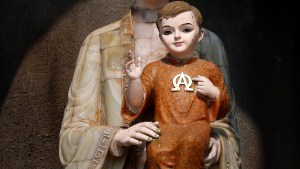“The community devoutly burns incense and offers it for the founding father / Taste the fragrance of incense to remember your beloved father”: These words, sung in Vietnamese in a small room in the Vicariate of Rome on a warm Friday in May, mark the start of the closing ceremony of the diocesan investigation into Fr. Benoît Thuân.
A notary seals with red wax the thick files that are passed on to the postulator, who will now have to defend the cause at the Vatican for recognition of the priest’s “heroic virtues,” the first step on the path to sainthood.
In the highly functional hall of the Lateran Palace, a large number of monks wear white tunics and black scapulars held together by a simple leather belt. Women wear the same habit, with the addition of a black veil over their heads. They are Cistercians, and many of them are Vietnamese.

“Today, almost half of all Cistercians come from Vietnam,” reveals the Order’s Abbot General, Fr. Mauro-Giuseppe Lepori. This fact owes much to the hero of the day, Fr. Benoît Thuân (1880-1933), who was originally from Pas-de-Calais.
A progressive vocation
Born in 1880 in Boulogne-sur-Mer, France, the man then known as Henri Denis joined the minor seminary of the port city at the age of 12, then moved on to the major seminary of Arras in 1900. But this son of the Opal Coast dreamed of going to sea to become a missionary, and left his homeland in 1901 for the Foreign Missions seminary in Paris.
After a brief period of formation, he was ordained in 1903 and sent on a mission. For him, it was Hué, in what was then known as Cochinchina: Vietnam. There, the vicar apostolic, to help him integrate into his parish, gave him a new name: Benoît Thuân —which in Vietnamese means “obedient.”
Fr. Thuân was highly committed to his pastoral work and spoke both Vietnamese and Chinese. He flourished in this new land, but he felt the need for a contemplative presence, so he decided to establish a monastic community, the first male one in the country. Rome agreed, and in 1917 he founded Our Lady of Annam monastery in Phuoc Son with just one brother.
From the outset, he wanted his monastery to belong to the Cistercian family, and initiated the procedures for membership. Those years were hard, marked by hunger and the hostility of some locals, but little by little he won them over and gained the sympathy and respect of the population.
Under the protection of St. Thérèse
He received unexpected support for his mission when, in 1924, he wrote to the sister of St. Thérèse of the Child Jesus, shortly after the beatification of the little saint from Lisieux in 1923 (she was canonized in 1925).
In her reply, Mother Agnes of Jesus announced that her then-blessed sister, who had almost been sent to Vietnam, would be the “protector of the community.”

“Fr. Thuân was very well known in his time,” says Abbot Jean XXIII Nguyễn Văn Sơn, who is the current Father Abbot of the abbey founded by the Frenchman. Fr. Thuân died in 1933, even before his monastery officially joined the Cistercians in 1935, but remains recognized as the founder of the local congregation.
Today, Vietnamese Catholics know little of Fr. Thuân, due to the great silence and persecution that they suffered after the arrival of Communism. But a path to canonization could change things: “For the Catholic faithful of Vietnam, it’s a great joy,” says Father Abbot Jean XXIII.
The fruits of the missionary monk
“Fr. Thuân has borne fruit,” continues the abbot, who recalls testimonies from old monks in his community who knew him personally. The Congregation of the Holy Family, the Vietnamese branch of the order founded by the Frenchman, now has 12 monasteries in Vietnam, including three women’s communities, and more than 1,300 members.
“Fr. Thuân is very relevant today, and personally inspires me,” explains Abbot General Mauro-Giuseppe Lepori. “Monastic life often lacks a bit of the missionary dimension, and missionary life sometimes lacks the contemplative dimension of monastic life,” explains the Swiss monk, considering that this kind of saintly figure offers a “balance” and can represent a model for the future of his order.




